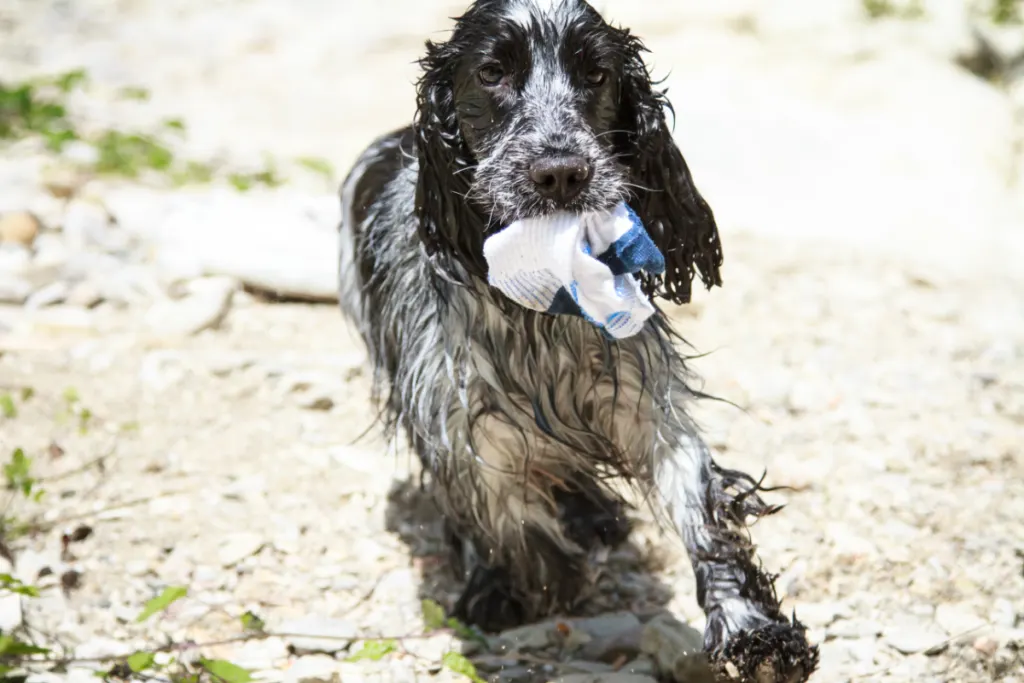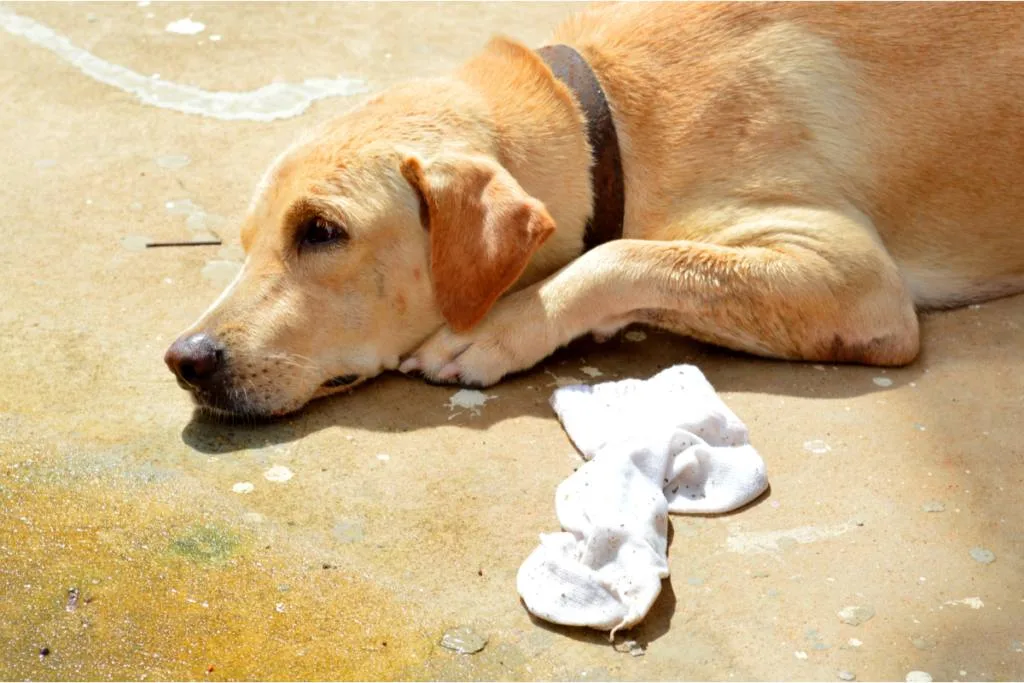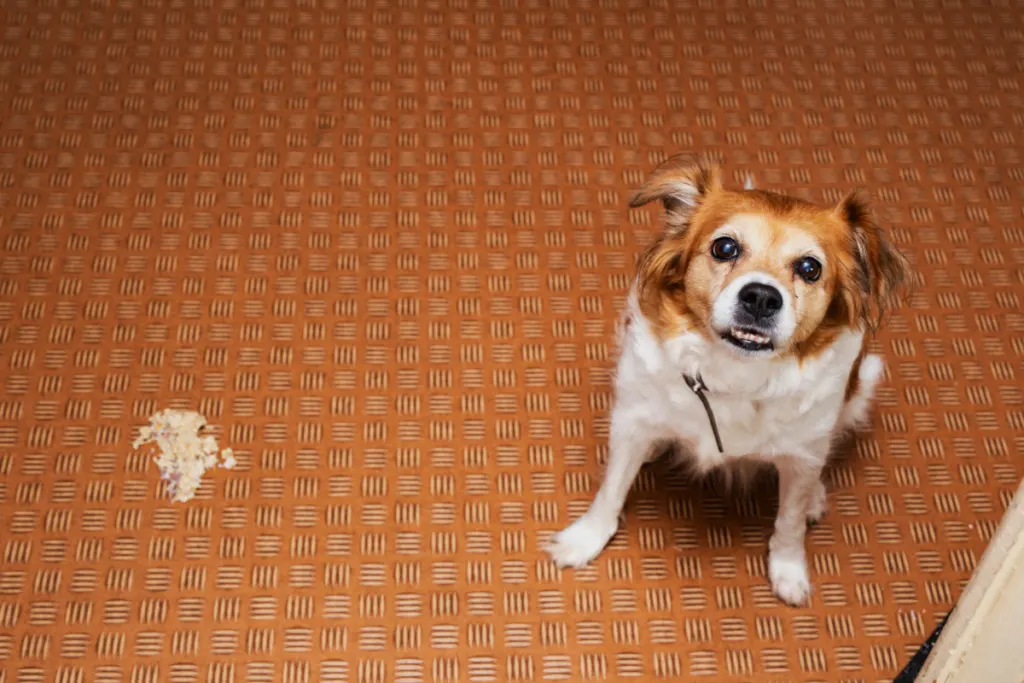Dogs are notorious for eating strange objects. One strange object high on the dog’s desirability list is socks. Owners are rightly alarmed when they witness the end of the sock disappearing into their dog’s mouth.
If your dog ate a sock, consult a vet immediately. If veterinarian assistance is not possible, try to induce vomiting so that the sock is regurgitated. The last option is to wait and see if the dog passes the sock during defecation. There are risks associated with managing the problem at home.
Many young dogs and puppies eat questionable items such as socks. They may outgrow this, but some dogs never seem to get past this stage.
Labrador retrievers and Pitbulls are breeds renowned throughout veterinary circles for consuming odd objects throughout their life.
My Dog Ate A Sock – What Should I Do?

If you see your dog swallowing a sock and are fast enough, you may be able to grab the end.
Slowly apply consistent pressure to the sock and pull it back up the dog’s esophagus and out the mouth. If you feel pressure or note that the sock is not budging, it is time to get the dog to the vet urgently.
Most times, the pet owner is too late and sees only the tip of the sock as the dog swallows it.
Some dogs think stealing socks is a wonderful game as the owner chases to get them back.
Just as the owner gets within reach of the dog, there is a mighty gulp, and the dog looks thoroughly pleased with himself as the sock disappears down his gullet.
In this case, the pet owner is sure the dog has swallowed a sock and may be panicking at the outcome.
Your veterinarian will likely inform you that there are three potential solutions for managing the problem:
(This means that calling your veterinarian should be your priority if your dog has eaten a sock!)
- Bring your dog to the vet immediately.
- Induce vomiting at home.
- Wait to see if the dog passes the sock.
What Will A Vet Do For My Dog That Ate A Sock?

It is important to get your dog veterinary help as soon as possible. If your vet works on an appointment basis, call the office and explain the situation so that they know it is time-sensitive.
A sock still in the stomach is easier to deal with than one that has moved into the intestines.
The vet will palpate the dog’s stomach and assess the gastrointestinal system for bloating, swelling, or blockages.
Abdominal radiographs and ultrasounds can help the vet determine where the sock is located.
The vet may induce vomiting if the sock is still in the stomach. This is usually done using one of three medicines:
- Apomorphine (an opioid derivative)
- Xylazine is not as popular as Apomorphine due to the side effects of heavy sedation and hypotension.
- Hydrogen peroxide (3%)
If the dog fails to vomit up the sock, the vet may opt for removing the sock using an endoscope while the dog is anesthetized.
This is a relatively safe, quick procedure, and the dog is only anesthetized for a short time.
If the sock has moved into the small intestines, the task of removing it becomes much more difficult and costly.
The sock will need to be removed surgically. Cutting into the intestines always carries a higher risk, and recovery must be carefully managed.
If the sock is in the large intestines and there is no evidence of complications, the vet may suggest that the dog’s feces are monitored to ensure the sock is passed.
If the sock is not passed within a reasonable amount of time, surgery may be necessary.
(Source: AKC; MSD Vet Manual)
What Can I Do At Home To Induce Vomiting?

The first thing that you always must do is to call your veterinarian. If you plan on inducing vomiting at home, calling your veterinarian for specific instructions for your dog is critical. We cannot stress this enough:
NEVER INDUCE VOMITING FOR YOUR DOG UNLESS IT IS UNDER THE DIRECTION OF YOUR VETERINARIAN.
The veterinarian will give you instructions specific to your dog, but it is likely that he or she will instruct you with some variation of the following:
- It is critical that only the 3% hydrogen peroxide solution is used. Do not use hydrogen peroxide from hair treatments, as this is too strong and will poison the dog and cause damage to the stomach lining.
- The usual dose is one teaspoon of 3% hydrogen peroxide per five pounds of body weight.
- For dogs weighing more than forty-five pounds, a maximum of three tablespoons (nine teaspoons) should be administered.
- Use a feeding nozzle syringe or turkey baster to introduce the hydrogen peroxide into the dog’s mouth.
- The best method is to slip the syringe nozzle between the dog’s back teeth. Take care not to squirt the liquid with a force so that the dog aspirates (i.e., breathes) it into the lungs.
- If your dog has not vomited in fifteen minutes, a second dose can be given. The dog will vomit forty-five to sixty minutes after being given hydrogen peroxide.
- If the dog swallowed the sock more than two hours previously, the sock will have moved into the small intestines. Inducing vomiting will achieve nothing other than distressing your dog.
Your veterinarian will also likely tell you to not induce vomiting in the following instances:
- Your dog is a brachycephalic breed. Examples are boxers, pugs, and bulldogs.
- The dog is already vomiting.
- The dog is unconscious.
- The dog is having seizures.
- The dog is having breathing difficulties.
Also, that risks of inducing vomiting at home include:
- Aspiration pneumonia, i.e., the hydrogen peroxide, went into the lungs instead of the stomach, which resulted in the dog getting pneumonia.
- Toxicity and damage from using too much hydrogen peroxide or a too strong solution.
- Adverse reactions such as bloat, torsion (GDV), and gastric ulcers.
(Source: AKC)
It is also important that you thoroughly clean up the area in which your dog has vomited, especially if it is on your carpet.
If your dog’s vomit has a chance to sink deeply into the fibers of your carpet, the odor and discoloration can actually be permanent.
For this reason, we recommend using a cleaner specifically designed for tasks such as this. And trust us on this one – there is a best product for this, and it’s called “Nature’s Miracle Stain & Odor Remover.”
This product specifically targets bio-based messes (including vomitus and poop – and yes, “vomitus” is a word!).
In other words, it breaks down the mess and doesn’t just cover it up with scent – this is what you want!
Moving on…
Can A Dog That Swallowed A Sock Pass It During Defecation?

Dogs frequently pass foreign objects, including socks, in their stool.
Some vets may even advocate a wait and watch approach to see if the dog passes the sock.
Big breed dogs are most likely to pass the sock or spontaneously vomit it up, e.g., Labrador Retrievers, Bull Mastiffs, and Great Danes.
Small breed dogs that eat a sock seldom manage to pass it through their gastrointestinal system.
There is not enough room for something as bulky as a sock. Puppies will also have the same difficulty.

If the dog can get rid of the sock during defecation, it should be passed within ten to twenty-four hours.
However, your veterinarian will likely inform you that this approach risks the sock becoming lodged in the gastrointestinal system, causing a blockage.
Any obstruction of the digestive tract is life-threatening and requires emergency surgery.
Final Thoughts
Dogs that eat socks can potentially cause life-threatening health risks.
Some dogs seem to swallow unbelievable objects that they either vomit up or pass through without any problems.
It is always preferable to consult a vet for guidance on managing the situation.
